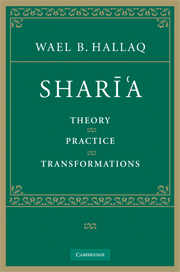Book contents
- Frontmatter
- Contents
- Preface and acknowledgments
- Introduction
- Part I The pre-modern tradition
- Part II The law: an outline
- 6 The legal pillars of religion
- 7 Contracts and other obligations
- 8 Family law and succession
- 9 Property and ownership
- 10 Offenses
- 11 Jihād
- 12 Courts of justice, suits and evidence
- Part III The sweep of modernity
- Appendix A Contents of substantive legal works
- Appendix B Chronology
- Bibliography
- Index
12 - Courts of justice, suits and evidence
Published online by Cambridge University Press: 05 June 2012
- Frontmatter
- Contents
- Preface and acknowledgments
- Introduction
- Part I The pre-modern tradition
- Part II The law: an outline
- 6 The legal pillars of religion
- 7 Contracts and other obligations
- 8 Family law and succession
- 9 Property and ownership
- 10 Offenses
- 11 Jihād
- 12 Courts of justice, suits and evidence
- Part III The sweep of modernity
- Appendix A Contents of substantive legal works
- Appendix B Chronology
- Bibliography
- Index
Summary
Almost every work of fiqh contained three chapters or “books” that, from a modern perspective, may be characterized as belonging to the law of procedure. The first of these chapters usually dealt with the qāḍī and his adab, namely, the conditions and terms of his appointment, conduct and work while in tenure. The prescriptions extend from personal characteristics and state of mind to the procedure he must follow in his court, all of which, as always, are subject to the multiplicity of legal opinion (khilāf; ikhtilāf). The second traditionally deals with the obligations and rights of plaintiffs and defendants, and how a suit (daʿwā) must open, proceed and end. The third chapter addresses evidence, especially oral testimony (shahādāt), but it also deals with written instruments, oaths, confessions and related matters.
Lawsuits
Although the greater bulk of the matters handled by the Muslim court did not involve litigation, an important function of the court was obviously the resolving of disputes. The qāḍī was under the legal and moral obligation to hear and adjudge all disputes (except for those which involved conflict of interest), and was forbidden to turn away claimants or disputants, even if they appeared before him outside his schedule. “Razing injustice” was the qāḍī's unqualified duty, to be fulfilled effectively and without undue delay. Protracted adjudication and postponements in the judicial process were thus abhorred, and deemed to aggravate injustice.
Much of the discourse in this literature was dedicated to the ethics of litigants' treatment by the qāḍī.
- Type
- Chapter
- Information
- Sharī'aTheory, Practice, Transformations, pp. 342 - 354Publisher: Cambridge University PressPrint publication year: 2009

